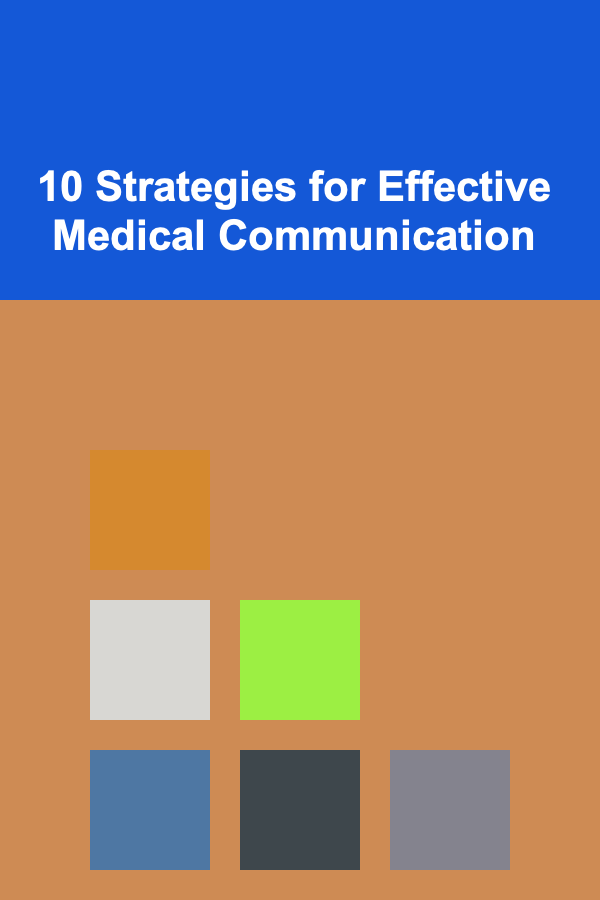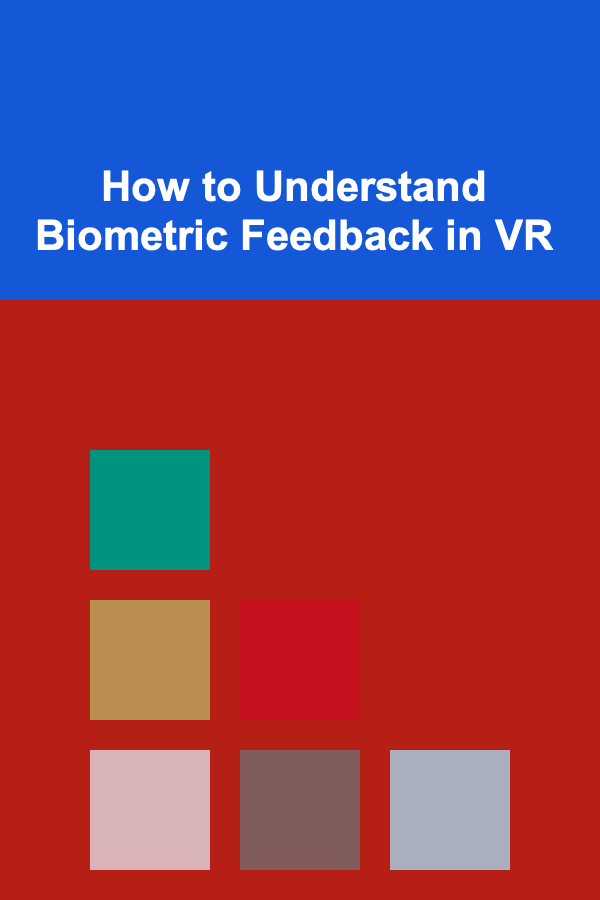
10 Strategies for Effective Medical Communication
ebook include PDF & Audio bundle (Micro Guide)
$12.99$10.99
Limited Time Offer! Order within the next:

Effective medical communication is critical in ensuring that patients receive the highest standard of care and that healthcare professionals work collaboratively to provide the best outcomes. From a doctor's consultation to emergency room interactions, communication can significantly impact the quality of care, patient satisfaction, and overall health outcomes.
In this article, we will discuss ten strategies for effective medical communication. These strategies will not only help healthcare professionals engage better with their patients but also enhance team collaboration, improve patient understanding, and ultimately drive better health outcomes.
Establishing Trust and Rapport
The foundation of effective medical communication is trust. Patients need to feel comfortable and confident in their healthcare providers. Establishing trust requires empathy, professionalism, and clear communication.
Why Trust Matters
- Patient Comfort: When patients trust their healthcare provider, they are more likely to share critical information about their health, which can lead to better diagnoses and treatment plans.
- Collaborative Relationship: Trust fosters a partnership between patients and providers. It encourages patients to follow treatment plans and makes them more receptive to recommendations.
- Emotional Reassurance: In stressful medical situations, a provider who communicates with empathy and understanding can help alleviate anxiety and fear.
Healthcare professionals can establish trust by actively listening, maintaining eye contact, and validating the patient's concerns. Using a calm and reassuring tone, as well as showing genuine care for the patient's well-being, can build a strong rapport early in the interaction.
Active Listening
Active listening is a vital communication skill that healthcare professionals must master. This involves not just hearing what a patient says but truly understanding the meaning behind their words.
Benefits of Active Listening
- Increased Patient Satisfaction: When patients feel heard, they are more satisfied with their care and more likely to adhere to medical recommendations.
- Better Diagnoses: Often, patients provide critical clues about their condition that can be easily overlooked if the provider is not actively listening.
- Empathy and Support: Listening attentively allows healthcare providers to better understand a patient's emotional state and respond with empathy.
Practicing active listening involves giving the patient undivided attention, asking open-ended questions, and providing feedback that indicates you've understood their concerns. It also means avoiding interruptions and giving patients enough time to express themselves fully.
Simplifying Medical Jargon
Medical professionals often use complex terminology that can confuse patients. While medical jargon is necessary in professional settings, simplifying language is key when communicating with patients to ensure they understand their diagnosis and treatment options.
Why Simplified Language is Crucial
- Enhanced Patient Understanding: Patients are more likely to follow through with treatment plans when they understand what's happening to their health.
- Improved Compliance: When medical terms are simplified, patients feel more confident in making decisions about their care, improving the likelihood of adherence to the prescribed treatment.
- Reducing Anxiety: Complicated medical terms can intimidate patients and cause unnecessary stress. Clear communication alleviates these concerns.
Healthcare providers can use analogies or everyday language to explain complex concepts, ensuring that patients grasp important details without feeling overwhelmed.
Cultural Sensitivity
Cultural competence is a critical component of medical communication. Understanding the cultural context in which a patient lives allows healthcare professionals to better address their needs, preferences, and potential barriers to care.
Benefits of Cultural Sensitivity
- Respect for Diversity: Cultural sensitivity fosters a more inclusive and respectful environment for patients from all backgrounds.
- Improved Communication: By understanding cultural nuances, healthcare providers can tailor their communication style and approach to resonate better with the patient.
- Better Health Outcomes: Culturally competent care can bridge gaps in understanding and ensure that treatment plans align with a patient's values and beliefs, leading to better outcomes.
To practice cultural sensitivity, healthcare providers should educate themselves about the backgrounds of the communities they serve. This involves asking respectful questions, being aware of cultural norms, and recognizing when an interpreter might be necessary to ensure accurate communication.
Providing Clear Instructions
Clear, concise instructions are essential for ensuring that patients understand what to do after leaving the healthcare setting. Whether it's taking medication, scheduling follow-up appointments, or following specific instructions related to a treatment plan, clear guidance ensures that patients follow through on the care plan.
Why Clear Instructions Matter
- Patient Autonomy: Clear instructions empower patients to take an active role in their health and make informed decisions.
- Reduced Misunderstandings: Clear communication helps to prevent errors related to medication dosages, appointment times, and post-treatment care.
- Increased Compliance: When patients clearly understand what is expected of them, they are more likely to adhere to the prescribed treatment.
Healthcare providers can enhance the clarity of their instructions by using written materials, visual aids, or even repeat-back techniques to ensure understanding. It's also helpful to invite patients to ask questions if they're unclear about any part of the instructions.
Non-Verbal Communication
Non-verbal communication can significantly influence how messages are received. In the healthcare environment, body language, facial expressions, and tone of voice play a crucial role in conveying empathy, authority, and clarity.
Importance of Non-Verbal Cues
- Building Trust: Non-verbal cues such as maintaining eye contact, offering a warm smile, or nodding in acknowledgment can help build a rapport with patients.
- Conveying Empathy: Subtle gestures, such as placing a hand on a patient's shoulder or using a reassuring tone, can express empathy and comfort.
- Reinforcing Verbal Communication: Non-verbal signals can reinforce or contradict what is being said verbally, making it important to ensure both are aligned.
Healthcare professionals should be mindful of their body language, posture, and facial expressions. This includes facing the patient, leaning slightly forward to show attentiveness, and using appropriate gestures to emphasize key points.
Patient Education and Empowerment
One of the most effective ways to enhance medical communication is through patient education. When patients understand their condition and treatment options, they feel more empowered to make decisions and engage actively in their care.
Benefits of Patient Education
- Increased Adherence: Patients are more likely to follow through with a treatment plan when they understand its purpose and potential benefits.
- Informed Decision-Making: Educated patients can make better decisions about their care, which leads to improved outcomes.
- Self-Management: Teaching patients how to manage their health condition outside the clinical setting can lead to better long-term health.
Using visual aids, pamphlets, online resources, or even patient portals can help improve understanding. Healthcare providers should take the time to explain conditions and treatments in a way that is accessible and understandable, ensuring that patients feel confident in their ability to manage their health.
Empathy in Communication
Empathy is the ability to understand and share the feelings of another person. In healthcare, showing empathy is essential for building strong provider-patient relationships and for fostering a supportive, healing environment.
The Role of Empathy
- Emotional Support: When patients are facing serious health challenges, a provider's empathy can make them feel supported and cared for.
- Improved Communication: Empathy allows healthcare providers to understand the patient's emotional and psychological state, leading to more effective communication.
- Increased Satisfaction: Patients who feel that their healthcare provider understands and cares about them are more likely to report higher satisfaction with their care.
Healthcare providers can demonstrate empathy by acknowledging the patient's feelings, offering emotional support, and using phrases that show understanding, such as, "I can see that you're feeling anxious about this, and I want to help."
Collaboration Among Healthcare Professionals
Effective communication within healthcare teams is just as important as communication between providers and patients. A collaborative approach ensures that the care provided is cohesive, comprehensive, and of the highest quality.
Benefits of Team Collaboration
- Comprehensive Care: When healthcare providers communicate effectively, patients benefit from a more integrated care plan that addresses all aspects of their health.
- Reduced Errors: Clear communication within the team helps to prevent misunderstandings that could lead to medical errors.
- Better Outcomes: Collaboration improves the decision-making process and allows for a more thorough consideration of treatment options.
Healthcare professionals should engage in regular team meetings, share critical patient information, and ensure that everyone involved in the care process is on the same page. This includes clear documentation, respectful dialogue, and coordinated care plans.
Using Technology to Enhance Communication
In the modern healthcare landscape, technology can be a powerful tool for improving medical communication. From telemedicine to patient portals and communication apps, technology allows for faster, more efficient, and often more convenient exchanges of information.
Why Technology is Vital
- Access to Information: Technology allows patients to access their health information, ask questions, and receive timely responses from their healthcare providers.
- Remote Care: Telemedicine has made it easier for patients to consult with healthcare providers without the need for in-person visits, especially for follow-up care or routine check-ups.
- Patient Monitoring: Wearable devices and remote monitoring tools enable healthcare providers to track patient progress in real-time, improving communication and care.
Healthcare providers should make use of available technologies to enhance communication with patients and among medical teams. This could involve using secure messaging platforms, telehealth services, or digital tools to monitor patient health.
Conclusion
Effective medical communication is not just about conveying information---it's about building trust, fostering collaboration, and ensuring that patients feel heard, understood, and supported. By implementing strategies such as active listening, simplifying medical jargon, and using empathy, healthcare professionals can create a more positive and productive healthcare experience for their patients.
The importance of communication in healthcare cannot be overstated. By refining these skills, healthcare providers can improve patient outcomes, enhance satisfaction, and create an environment where patients feel truly cared for. Whether through face-to-face interactions, technology, or collaborative efforts within medical teams, communication is the key to delivering exceptional care.
Reading More From Our Other Websites
- [Personal Investment 101] How to Use Deep Learning to Generate a Consistent Passive Income
- [Organization Tip 101] How to Develop a System for Managing Spare Keys
- [Home Space Saving 101] How to Upgrade Your Shower Caddy Ideas from Basic to Brilliant with DIY Solutions and Smart Drainage
- [Home Budget Decorating 101] How to Find Affordable Home Decor for Small Spaces: Maximizing Every Inch
- [Home Maintenance 101] How to Maintain Your Home's Septic System Regularly
- [Personal Investment 101] How to Use Dollar-Cost Averaging: A Strategy for Smarter Investing
- [Organization Tip 101] How to Keep Your Car Clean and Organized
- [Organization Tip 101] How to Create a Go-To Recipe List for Weeknight Dinners
- [Organization Tip 101] How to Evaluate Your Seasonal Wardrobe Needs
- [Soap Making Tip 101] Time-Saving Soap-Making Gadgets You Didn't Know You Needed

How to Build a Checklist for Holiday Entryway Decorations
Read More
How to Create a Checklist for Optimizing Social Media Profiles
Read More
How to Practice Mindful Eating
Read More
How to Understand Biometric Feedback in VR
Read More
Feng Shui Your Living Room: Creating a Welcoming Space
Read More
10 Tips for Writing Prompts Centered Around Specific Settings
Read MoreOther Products

How to Build a Checklist for Holiday Entryway Decorations
Read More
How to Create a Checklist for Optimizing Social Media Profiles
Read More
How to Practice Mindful Eating
Read More
How to Understand Biometric Feedback in VR
Read More
Feng Shui Your Living Room: Creating a Welcoming Space
Read More